
Is it possible to cure baldness?
Is it possible to cure baldness?
There are a variety of treatments available for hair loss, ranging from medical interventions to changes in lifestyle and diet. While there is no cure for baldness, there are treatments that can encourage hair regrowth. These include medication, surgery, and low-level laser therapy. In some cases, changing your hairstyle or using products that stimulate hair growth can also be effective. If you're concerned about hair loss, it's best to speak to a dermatologist or other medical professional who can help you choose the most effective treatment for your situation.
How do we grow and how do we lose hair?
Hair follicles grow in a repeating cycle of three phases: anagen, catagen, and telogen. The anagen phase is the active growth phase, during which the hair follicle grows and the hair shaft elongates. This phase lasts for two to seven years. The catagen phase is a transitional phase that lasts for about two to four weeks. During this phase, the hair follicle shrinks and the hair shaft breaks off. The telogen phase is a resting phase that lasts for about 100 days. During this time, the hair follicle does not grow and the old hair shaft remains in place. At the end of the telogen phase, a new anagen phase begins and the cycle repeats itself.
Some hair follicles stop growing and enter the telogen phase sooner than others, which is why we experience hair shedding. When a follicle stops producing new hairs, it dies. This process of follicle death is called apoptosis. Once a follicle dies, it cannot grow back. This is why baldness is permanent once it has occurred.
Although there is no cure for baldness, there are several types of treatments available for those who want to change their appearance. These treatments include medication, surgery, and topical treatments.
Stem cell therapy for hair loss
Hair follicles are composed of different types of cells, including stem cells. Stem cells are a type of cell that can divide and renew themselves indefinitely. They play an important role in the growth and repair of tissues throughout the body. In the hair follicle, stem cells help to maintain the structure of the follicle and promote new hair growth.
Researchers are investigating the use of stem cells to treat a variety of diseases and conditions, including hair loss. One type of stem cell treatment that is being studied is called autologous hair follicle transplantation. This procedure involves taking stem cells from the person’s own body and injecting them into the scalp. The hope is that the transplanted stem cells will help to regenerate new hair follicles and promote hair growth.
Although this treatment is still in the early stages of research, it shows promise as a potential treatment for hair loss. However, more research is needed to determine whether or not this treatment is safe and effective.
Alopecia areata treatments
There is no cure for alopecia areata, but there are treatments that can help to improve the appearance of the hair. The most common treatment for alopecia areata is topical corticosteroids. These medications are applied to the scalp and work by reducing inflammation. Other treatments include intralesional corticosteroids, which are injected into the affected areas of the scalp, and topical immunotherapy, which involves applying a chemical to the scalp that triggers an immune response. In some cases, surgery may be an option. This includes hair transplantation, in which healthy hair follicles are transplanted from other areas of the body to the balding area of the scalp.
Androgenetic alopecia (male pattern baldness) treatments
The most common type of hair loss is male pattern baldness, which affects approximately 50% of men by the time they reach the age of 50. Male pattern baldness is caused by a combination of genetic and hormonal factors. For people with androgenetic alopecia, some treatments can help to slow down the progression of hair loss or promote hair re-growth. The most common treatment for androgenetic alopecia is minoxidil. This medication is applied to the scalp and works by increasing blood flow to the hair follicles and by stimulating new hair growth. Other treatments include finasteride, which is a pill that is taken orally, and dutasteride, which is a cream that is applied to the scalp. Hair loss treatments can be effective, but they are not always successful, depending on the cause of hair loss and whether it is reversible. The best way to prevent hair loss is to start treatment early.
Microneedling for hair growth
Microneedling is a minimally invasive procedure that involves using fine needles to create tiny punctures in the skin. This process can help to stimulate collagen production and hair growth. It is often used to treat wrinkles, scars, and stretch marks. It can also be used to treat hair loss.
One study found that microneedling was effective in promoting hair growth in people with androgenetic alopecia, also known as male pattern baldness. The study found that microneedling increased hair density by 36% after six months of treatment. Another study found that microneedling was effective in treating alopecia areata, an autoimmune condition that causes patchy hair loss. It reported that microneedling increased hair growth in 86% of participants after eight weeks of treatment.Microneedling is a safe treatment for hair loss, but it is important to note that the results of this treatment are not immediate and that there is a limited number of studies examining its effectiveness in hair growth.
Hair growth laser treatment
Laser therapy is a treatment that uses low levels of laser energy to stimulate hair growth. The laser energy helps to increase blood flow to the hair follicles and stimulates the production of new hair. Laser therapy is often used to treat androgenetic alopecia, also known as male pattern baldness. One study found that laser therapy was effective in treating androgenetic alopecia in men. The study found that after 26 weeks of treatment, participants had an increase in hair density of 19%. Another study found that laser therapy was effective in treating androgenetic alopecia in women. The study found that after 24 weeks of treatment, participants had an increase in hair density of 13%.
There are two types of laser therapy products: hand-held devices and combs. Hand-held devices are usually more expensive than combs, but they offer a more concentrated level of laser energy and can be used more easily on larger areas of the scalp. Combs can be less expensive, but they require regular use and may not be as effective as hand-held devices.
Scalp reduction
Scalp reduction is a surgical procedure that involves removing a section of the scalp. This can help to reduce the amount of hair loss by making the area of the scalp where hair loss is occurring smaller. Scalp reduction surgery can be combined with other hair loss treatments, such as hair transplants, to provide the best results.
One study found that scalp reduction was effective in reducing hair loss in people with androgenetic alopecia. The study found that after 12 months of treatment, participants had an average decrease in the balding area of 36%. However, another study found that scalp reduction was not effective in treating androgenetic alopecia. This study found that after 12 months of treatment, participants had no change in the balding area, compared to those people who did not undergo this surgical procedure.
Hair transplants
Hair grafting is a surgical procedure that involves taking hair from one area of the scalp and surgically transplanting it to another area of the scalp. This can help to give the appearance of fuller, thicker hair.
There are two types of hair transplants: follicular unit transplantation and follicular unit extraction. Follicular unit transplantation is a surgical procedure that involves taking hair from the back of the scalp and transplanting it to the balding area. Follicular unit extraction is a surgical procedure that involves taking hair from the back of the scalp and transplanting it to the balding area. This type of hair transplant is less invasive than follicular unit transplantation and can be done in one session. Follicular unit transplantation is usually done in multiple sessions, with each session taking about 4 to 8 hours.After hair grafting surgery, it is common to experience some pain and discomfort. This is typically mild and can be managed with over-the-counter pain medications. However, some people may experience more severe pain, which may require prescription medication. It is important to talk to your doctor about any pain you are experiencing after surgery so that they can determine the best course of treatment.
Temporary treatments for hair loss
Hair loss concealers are products that can be used to cover up bald spots or areas of thinning hair. They come in the form of powders, creams, and sprays and can be applied to the scalp to create the illusion of thicker, fuller hair.
There are a variety of hair loss concealers available on the market. It is important to choose a hair loss concealer that matches your skin tone. If the concealer is too light or too dark, it will be noticeable and may not give you the desired results.
Hair pieces and wigs are another type of product that can be used to cover up bald spots or areas of thinning hair. They can be custom-made to match your hair colour and style.
Hair pieces and wigs can be made from real human hair or synthetic fibres. Real human hair pieces and wigs are more expensive than those made from synthetic fibres.
They can be a temporary or permanent solution to hair loss. They can be used to cover up bald spots or areas of thinning hair until more permanent solutions, such as hair transplants or medication, can be used. Compared to hair transplants, hair pieces and wigs are painless but require care and maintenance. They should be washed and styled regularly to keep them looking their best.
Conclusion
There are a variety of treatments available for hair loss. Some treatments are more effective than others. Scalp reduction surgery and hair transplants are two surgical procedures that can be used to treat hair loss. These procedures can be effective in reducing hair loss, but they also come with some risks and side effects. There are also several temporary treatments available, such as hair loss concealers, hair pieces, and wigs. These treatments can be used to cover up bald spots or areas of thinning hair.
It is important to talk to your doctor about the best treatment option for you. Different people will respond differently to different treatments. There is no one-size-fits-all solution to hair loss. What works for one person may not work for another. Your doctor can help you find the best treatment option for you based on your individual needs and medical history
There are several reasons why it is better to accept your hair loss than to undergo treatment. Hair loss is a natural part of the ageing process and is not usually a sign of an underlying medical condition. Treatment for hair loss can be expensive and may not be covered by insurance. Treatment can also be painful and may have side effects, such as scars, infections, and numbness. In some cases, hair loss may be temporary and will eventually grow back on its own. Accepting your hair loss can be easier than undergoing treatment, which may not be effective.

